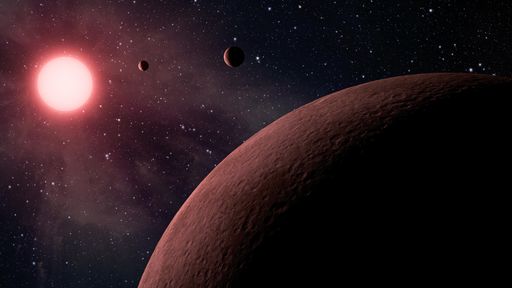Sport
Dollar
42,9251
0.17 %Euro
50,5914
-0.16 %Gram Gold
6.252,4900
1.32 %Quarter Gold
10.319,2000
1 %Silver
106,6500
7.64 %The team identified planets around three stars, including TOI-5799c, which may have an atmosphere and conditions suitable for liquid water.

A global team of astronomers led by a Turkish scientist Selcuk Yalcinkaya has discovered four new exoplanets — planets outside our Solar System — one of which lies within the inner edge of its star’s habitable zone and may have an atmosphere. The planets are 90 light-years away from Earth.
The discoveries, two orbiting the small, cool star TOI-5799 and one each around TOI-1743 and TOI-6223, were made using data from the AU Kreiken Observatory and the Turkish National Observatory.
The findings were part of Yalcinkaya’s doctoral research on the “discovery and validation of four super-Earth to Neptune-sized planets around M dwarfs,” published in the October 2025 issue of Astronomy & Astrophysics.
One of the exoplanets found orbiting the TOI-5799, namely the TOI-5799c, was found to be within the star’s habitable zone, albeit 90 light-years away from Earth.
Yalcinkaya told Anadolu that the planets his team discovered were previously identified as exoplanet candidates after observations on the TESS Space Telescope.
The telescope monitors transit signals over a 30-day period in space, while researchers on Earth use observatory telescopes to identify which star in the region is emitting the signal and determine whether it originates from that star or another nearby one.
Potential habitability
“One of the planets we discovered, the TOI-6223b, is the size of Neptune but very close to its own star, which is why it’s called a hot Neptune,” he said. “While it has a radius similar to that of Neptune’s, we need to look at what gases are present in its atmosphere.”
“Meanwhile, the other one, the TOI-1743b, is a super-Earth — it is about 70 percent larger than our planet and it is terrestrial,” he noted. “It probably can’t retain volatile gases in its atmosphere — it is also very close to its star and therefore hot.”
Yalcinkaya said the TOI-5799 system stands out as one of the stars hosting two of the newly discovered exoplanets, TOI-5799b and TOI-5799c, both about 70 percent larger than Earth and likely terrestrial.
While TOI-5799b orbits close to its star and is therefore hot, TOI-5799c lies within the star’s habitable zone and completes an orbit every 14 days.
“The exoplanet is at a distance where water could potentially exist as liquid due to its surface temperature of around 63 degrees Celsius, but the atmosphere could change things a bit as we don’t know what kind of atmosphere it has,” he said. “It could be much hotter than expected or colder, we don’t know yet.”
“If there’s life there, there may be some bio-signs in its atmosphere, we can observe this in the future to see if there’s life there or not,” he noted. “Life may exist on many planets, but if there’s life in the ‘TOI-5799c,’ it is possible to find out.”
Comments
No comments Yet




















Comment